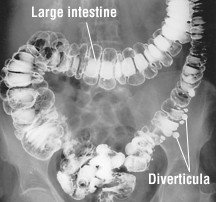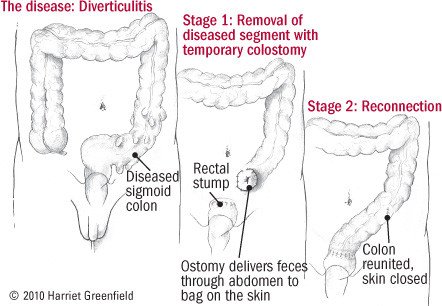Diverticulosis and Diverticulitis
Medically reviewed by Drugs.com. Last updated on Jan 22, 2024.
What is Diverticulosis and Diverticulitis?

In diverticulosis, small pouches develop and bulge out through weak spots in the walls of the colon, typically in the part of the colon called the sigmoid colon on the left side of the abdomen. These small, balloon-like pouches are called diverticula.
The condition is more prevalent as people age. For example, it is estimated that half of people in the United States aged 60 to 80 have diverticulosis, but only one person in 10 develops it by age 40. It is equally common in women and men.
|
|
If the diverticula become inflamed or infected, the condition is called diverticulitis.
Diverticulitis can lead to serious complications such as abscess, perforation, intestinal blockage from internal scarring, or fistula, which is an abnormal connection between two organs. A rare but life-threatening complication called peritonitis can occur when diverticula rupture, leaking infection into the abdominal cavity.
Symptoms
Most people who have diverticulosis don't have any symptoms, but some have mild cramps, constipation or bloating. Diverticulitis causes more severe symptoms, including any of the following, but particularly the first two:
-
Steady abdominal pain
-
Tenderness to pressure in the lower abdomen, especially on the left side
-
Chills
-
Cramping
-
Change in bowel habits (constipation or diarrhea)
-
Sharper pain with breathing or jarring movements such as walking.
Lower intestinal bleeding can occur in people with diverticulosis. The loss of blood can cause weakness and dizziness.
Diagnosis
The condition is more prevalent as people age. For example, it is estimated that half of people in the United States aged 60 to 80 have diverticulosis, but only one person in 10 develops it by age 40. It is equally common in women and men. However, unless you have had a colonoscopy, CT scan of your abdomen or barium enema, you would not be aware they exist.
On the other hand, diverticulitis almost always causes symptoms. Your doctor will ask about your medical history, bowel habits and diet and will conduct a physical examination. Your doctor will press on your abdomen to check for tenderness.
Based on the location of your symptoms and the location of abdominal pain and tenderness, your doctor may be able to make the diagnosis without further testing. If your doctor is unsure or concerned that you may have an abscess or other complication, he or she will likely order additional studies. These usually include blood tests for signs of infection and an abdominal computed tomography (CT) scan.
Lower intestinal bleeding is commonly caused by a broken blood vessel within a diverticula. But it is often very difficult to identify the exact bleeding site, even with colonoscopy.
Expected Duration
Diverticula do not disappear unless the section of colon is removed surgically. Diverticulosis is a lifelong condition that can be managed, primarily with adjustments in diet.
Symptoms of diverticulitis or bleeding from diverticulosis may subside within a few days after treatment, may continue, or may get worse in the case of severe illness or complications.
Prevention
People whose diets contain large amounts of fiber are less likely to develop diverticular disease. The recommended daily fiber intake is at least 20 grams per day, but a healthier goal is 35 grams of fiber daily, preferably from fruits, vegetables and grains. Your doctor also may recommend unprocessed bran or a fiber product. It is important to increase fiber intake gradually and to drink more water to increase the bulk of the bowel movements, which reduces pressure inside the bowel.
Physical activity also may lower the risk of diverticulosis. Many doctors previously recommended that people with diverticulosis avoid eating nuts, popcorn and foods with seeds. This restriction has not been proven to prevent diverticulitis.
Treatment
The only possible treatment for diverticulosis is to increase fiber in the diet. Fiber will not heal existing diverticula, but it may prevent more from forming.
If you have symptoms of mild diverticulitis, your doctor may recommend a short period of observation without antibiotics. There are no specific dietary recommendations, but many doctors suggest a low fiber diet until symptoms resolve. If the diagnosis is uncertain, an abdominal CT scan is usually ordered. Depending on the results, your doctor can then decide if treatment at home with oral antibiotics vs. intravenous (IV) antibiotics either at home or in the hospital.
If fever and pain continues, you may be developing complicated diverticulitis, For example, an abscess can develop when a diverticulum becomes perforated (develops a hole). An abscess is a collection of pus. A surgeon then will help your doctor plan the next step: drainage or surgery. The choice depends on the extent of the problem and your overall health. Drainage means that the surgeon cleans out the pus.
Surgery also may be required during the hospital stay to treat a particularly severe episode of diverticulitis. Emergency surgery is required if the abscess breaks open and causes peritonitis, the most serious potential complication of diverticulitis. Peritonitis requires surgical repair as well as intravenous antibiotics.
For persistent or recurrent bleeding from diverticulosis, surgery may be the only option.
The most common procedure, known as a colon resection, involves removing the part of the colon that contains the bleeding diverticula and reattaching the ends.
When done during emergencies, a colon resection is often done as a two-stage process. First, a section of colon is removed, but because of infection, it is not safe to rejoin the ends. Instead, the surgeon creates a temporary hole, or stoma, in the abdomen and connects the colon to it, a procedure called a colostomy. A bag is attached to collect the stool. Later, a second operation is done to reattach the end of the colon, and remove the colostomy.
|
|
After successful treatment for diverticulitis, your doctor normally will recommend a high-fiber diet. Later, you may need to have a procedure called a colonoscopy, which is an internal examination of the colon.
In general, surgery is not recommended after only one or even two attacks without complications. However, it is usually recommended after a third episode occurs in the same location within the colon.
Repeated episodes of diverticulitis can lead to internal scarring and narrowing of the colon, which also may require surgery to remove a piece of the colon.
When To Call a Professional
Call your doctor if abdominal pain in one spot lasts for longer than a few hours, especially if it becomes worse or is accompanied by fever.
Prognosis
With proper treatment and a high-fiber diet, the outlook for people with diverticulosis and uncomplicated diverticulitis is excellent. Most people with diverticulosis never have symptoms.
People who have diverticulitis usually improve within two to four days after treatment begins. Over 85% of patients recover with bed rest, liquid diet, with or without antibiotics. Most never have a second episode of diverticulitis.
The prognosis varies if complications develop and is particularly serious in the case of peritonitis.
About 90% of people who have a colon resection do not have symptoms return after the surgery.
Additional Info
National Institute of Diabetes & Digestive & Kidney Disorders
https://www.niddk.nih.gov/
Further information
Always consult your healthcare provider to ensure the information displayed on this page applies to your personal circumstances.


